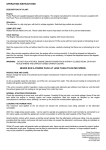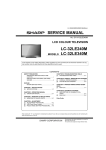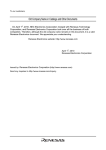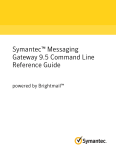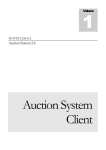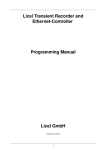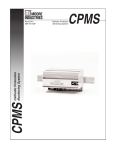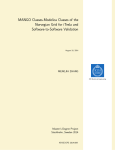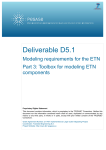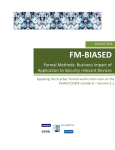Download Deliverable D2.3 Conversion tools from external formats to
Transcript
iTesla
Innovative Tools for Electrical System Security within Large Area
Grant agreement number
283012
Funding scheme
Collaborative projects
Start date
01.01.2012
Duration
48 months
Call identifier
FP7-ENERGY-2011-1
Deliverable D2.3
Conversion tools from external formats
to internal formats
Dissemination level
PU
Public.
TSO
Restricted to consortium members and TSO members of ENTSO-E (including the Commission Services).
RE
Restricted to a group specified by the consortium (including the Commission services).
CO
Confidential, only for members of the consortium (including the Commission services).
X
iTesla WP2 D2.3 : Conversion tools from external formats to internal formats
Document Name:
Work Package:
Task:
Deliverable:
Responsible Partner:
V1.0
Conversion tools from external formats to internal formats
WP2
2.3
D2.3
AIA
Author
Name
Approval
Name
Visa
Marc Sabaté [AIA]
Date
Executive Board
Geoffroy Jamgotchian [RTE]
[Quinary]
DIFFUSION LIST
For action
For information
All partners
DOCUMENT HISTORY
Index
0.0
0.1
1.0
Date
Author(s)
July 2013
Marc Sabaté
July 31 2013
Geoffroy Jamgotchian
August 1st 2013 Geoffroy Jamgotchian
Main modifications
Document creation
CIM import chapter added
Eurostag data import chapter added
1/20
iTesla WP2 D2.3 : Conversion tools from external formats to internal formats
V1.0
Table of contents
1.
INTRODUCTION ............................................................................................................................................... 4
2.
EUROSTAG TO MODELICA CONVERTER ............................................................................................................ 4
2.1.
2.2.
2.3.
3.
GENERAL OVERVIEW ............................................................................................................................................ 4
ANALYSIS OF THE MODEL FILE STRUCTURES ............................................................................................................... 5
CONVERTER ........................................................................................................................................................ 9
CIM TO IIDM CONVERTER .............................................................................................................................. 12
3.1.
3.2.
3.3.
CIM VERSION SUPPORTED ................................................................................................................................... 12
CONVERTER SOFTWARE ARCHITECTURE .................................................................................................................. 13
USING THE CONVERTER ....................................................................................................................................... 14
4.
EUROSTAG DYNAMIC DATA IMPORTER ......................................................................................................... 16
5.
REFERENCES ................................................................................................................................................... 17
6.
ANNEX ........................................................................................................................................................... 18
2/20
iTesla WP2 D2.3 : Conversion tools from external formats to internal formats
V1.0
Figures
Figure 1- Eurostag to Modelica converter in the general WP2 workflow....................................................... 4
Figure 2 - Modelica structure .......................................................................................................................... 7
Figure 3 - Correspondence table ..................................................................................................................... 8
Figure 4 - Converter GUI................................................................................................................................ 10
Figure 5 - CIM importer in the general WP2 workflow ................................................................................. 12
Figure 6 - Converter build workflow ............................................................................................................. 13
Figure 7 - Converter run workflow ................................................................................................................ 15
Figure 8 - Eurostag dynamic data importer in the WP2 general workflow................................................... 16
3/20
iTesla WP2 D2.3 : Conversion tools from external formats to internal formats
V1.0
1. INTRODUCTION
Deliverable D2.3 is of the “Prototype” type. It consists of three conversion tools from external data formats to the
iTesla internal data model (IIDM):
- Import of data in the Eurostag format,
- Eurostag to Modelica data converter,
- Import of data in the CIM format.
Source codes of theses conversion tools can be found on the iTESLA source code Git repository hosted at
www.bitbucket.org. The present document is an accompanying document that describes the main characteristics
of these tools.
2. EUROSTAG TO MODELICA CONVERTER
2.1. General overview
Within the iTesla project, WP2 provides common services for WP3, WP4 and WP5. Among them we find the
Eurostag to Modelica converter that translates Eurostag macroblocks to the Modelica language, using as input the
.frm, .fri and .par Eurostag files. These files will be contained in the Dynamic database and by calling the Modelica
converter from the user interface the corresponding Modelica file will be generated and stored inside the
database.
RTE load flow
data converter
CIM
importer
IIDM
WP5
CIM files
ENTSOEV1/2
Network data
model
AIA Agora load
flow data
converter
WP4/5
WP5
Contingencies
and actions
database
Eurostag data
converter
WP4/5
Modelica
dynamic
data
Dynamic
database
Optimizers
data converter
Data mining
database
feeder
WP4/5
Complementary
database
Full Modelica
network
converter
WP 3
Dynamic
database
UI
Eurostag
dynamic
data
Eurostag to
Modelica
converter
Data mining
database
Data
mining
platform
(Pépito, R,
etc)
Data
mining
functions
WP4/5
Eurostag
DD
importer
Figure 1- Eurostag to Modelica converter in the general WP2 workflow
4/20
iTesla WP2 D2.3 : Conversion tools from external formats to internal formats
V1.0
This converter will also be a useful tool for WP3, WP4 and WP5. It will be used to populate the Dynamic
database of the IIDM, which will be then used in the Eurostag data converter and in the Full Modelica network
converter (see Figure 1.).
In this document, the development of the “Eurostag to Modelica converter” (highlighted block in figure 1.) is
explained.
2.2. Analysis of the model file structures
2.2.1. Eurostag
A Eurostag macroblock is an assembly of elementary blocks with input-output relationship integrated into a
system by defining the input variables for the existing types of machines in the file editor module. Each block of the
macroblock performs a function (for further information, see [1] appendix 2) and has the following attributes:
•
•
•
•
•
•
•
A block identifier.
A graphical block identifier within the macroblock.
From 0 to n inputs.
A single output.
From 0 to n parameters.
From 0 to 1 initial value.
From 0 to 1 offset.
Three ASCII files define a Eurostag macroblock: .frm file corresponds to the main scheme of the macroblock, .fri
corresponds to the initialization scheme and .par corresponds to parameters.
2.2.1.1. Main Scheme
The .frm file defines the topology of the macroblock and has the following structure (for further details, see D2.2):
5/20
iTesla WP2 D2.3 : Conversion tools from external formats to internal formats
V1.0
HEADER
03/10/08 4.4
# Header with the date and the number of version to be used with the regulation
70
84 # Dimensions of the graphical representation (to be bypassed)
5 # Number of blocs
?
INTMAX
-KDELTAF
1.0
?#Blocs param
?
1.0
?
PROPHP*TRH
?#Blocs param
?
0.
1.0
TRH
?
#Blocs param
?
?
?
?
?
#Blocs param
?
?
1.0
?
?
#Blocs param
#Blocs param
?
?
?
?
?
?
?
KDELTAF
?
?
#Blocs offset
0.
^V1
?
^V1
0.
#Blocs init value
?
?
OMEGA
?
?
#Blocs entries
?
?
?
?
?
#Blocs entries
?
?
?
?
?
#Blocs entries
?
?
?
?
?
#Blocs entries
?
?
?
?
?
#Blocs entries
#Blocs output
$
/
&
$CM
$
1
2
4
5
6
# Graphical Blocks numbers
3741 3930 4153 4382 3930 # Location on the graphical representation (to be bypassed)(X axis)
3948 394839483948 4152 # Location on the graphical representation (to be bypassed) (Y axis)
26
7
1
10
26
# Type of the bloc (need of a table of correspondence)
0
0000# Orientation of the bloc (graphical: to be bypassed)
1
2
4
5
6
# Graphical Blocks numbers, again???
4 # Number of links
3822 40114011 4234 # Location on the graphical representation (to be bypassed)
...
3990
1
2
1
10
0
0
0
0
0
#
#
#
#
#
0
5
3
5
3
(to
(to
(to
(to
(to
be
be
be
be
be
# Location on the graphical representation (to be bypassed)
00# Location on the graphical representation (to be bypassed)
2
3
# Starting block of a link (blocs are 1,2,3,4,5, graphical numbers are: 1,2,4,5,6)
3
4 # Ending block of a link
3
1
# Number of entry in the extremity bloc
1
1# (to be bypassed)
bypassed)
bypassed)
bypassed)
bypassed)
bypassed)
This scheme will be the most important one for the conversion from Eurostag to Modelica language. It defines the
topology of the macroblock: which blocks appear in the macroblock, their parameters and their connections.
2.2.1.2. Initialization Scheme
The .fri file indicates that the Computation Module needs to initialize a macroblock (i.e. to give initial values to all
the state variables of the macroblock) within the simulation of a power system with Eurostag.
However, when a power system that contains a macroblock is simulated with Modelica, initialization calculations
are previously performed with Eurostag, and the initial resulting values for the state variables of the macroblock
are taken to initialize the Modelica macroblock. Hence, for the moment, the .fri file will not be taken into account
when converting a Eurostag macroblock to Modelica code.
2.2.1.3. Parameters scheme
The .par file provides all the parameters of the macroblock. In case there is more than one occurrence of the
macroblock in the system where it is integrated, the .par file also provides all the necessary sets of parameter
values corresponding to each occurrence of the macroblock. The set used in the simulation will be specified into
the dynamic data file.
6/20
iTesla WP2 D2.3 : Conversion tools from external formats to internal formats
HEADER
V1.0
17/04/12 4.5 RTE
_end_comment_
FLR
ALPHATR
DEUXPINU
K1
K2
K3
K4
KE
MESU
PLEXM
PLEXP
T
TC
TE
TF1
TF2
TOMD
TOMSL
TR
1
1.700000
314.1593
-5.10000
18.
18.70000
13.5
.4900000
0.02
-4.
4.600000
5.
0.02
0.2
2.940000
0.94
0.02
0.04
5.
2
3
4
5
2.400000 1.700000 2.400000
2.
314.1593314.1593314.1593314.1593
-5.10000 -3.40000 -3.40000 -2.64000
18.
16.
16.
22.
18.70000
12.
12.
8.
13.5 11.70000 11.70000 14.40000
.4900000
1.
1. 3.300000
0.020.020.020.02
-4.
-3.46
-3.46
-3.46
4.600000
4.
4.
4.
5.
5.
5.
5.
0.02
0.03
0.03
0.025
0.2 .3300000 .3300000 .3200000
2.940000 6.600000 6.600000
6.
0.94 4.200000 4.200000
4.
0.020.020.020.02
0.040.040.040.04
8.
5.
8.
8.
2.2.2. Modelica
The Modelica code of a model that is formed by several blocks and their input-output connections has the
following structure:
Initial values declaration
Parameters declaration
Blocks declaration
Input and output connectors of the macroblock declaration
Connections between blocks
Input connectors of blocks that don’t have input values
Figure 2 - Modelica structure
7/20
iTesla WP2 D2.3 : Conversion tools from external formats to internal formats
V1.0
When integrating this model into a power system, initialization calculations must be performed using Eurostag in
order to initialize each block in the Macroblock with the appropriate values. The reason for doing this is that the
initial values of Macroblock regulators are closely related to the type of system to be regulated.
Therefore,the .fri file of the homologous Eurostag Macroblock cannot be taken into account until the full “system
converter” from Eurostag to Modelica is implemented. At this stage, the converter is being developed with the goal
of converting Macroblocks independently of the power system where they are going to be connected.
2.2.3. Tools needed for the converter
The first step in the converter is to match each block of a macroblock with the homologous block defined in the
PowerSystems Modelica Library (see Deliverable D3.1 [3]), to identify the dependencies between blocks, and finally
to rewrite the macroblock in Modelica language. It will be then necessary to endow each block of the Modelica
library with the same attributes of the homologous Eurostag block.
On the other hand, the .frm file provides the Eurostag identifiers of the blocks used in the macroblock, the
parameters of each block, the offset and the initial values (if they exist). Therefore, a sort of dictionary identifying
each Eurostag block to the homologous Modelica model is needed; for this purpose a correspondence table has
been created (see Annex). It identifies each block coming from Eurostag with the correspondent Modelica block,
and it also provides (if they exist) the parameters names, the initial values names and the offset names of the
Modelica block:
Figure 3 - Correspondence table
Since the parameters in the .frm file are provided in a specific order, the parameters in the correspondence table
must follow the same order.
In addition, for the correct compilation of the translated Modelica model, correct paths for the Modelica blocks
have to be provided. In each new version of the library some blocks might change their location within the
packages. Thereby, after each update, a text file will be automatically created with the correct paths of all the
Modelica models in the PowerSystems library.
8/20
iTesla WP2 D2.3 : Conversion tools from external formats to internal formats
V1.0
2.3. Converter
This chapter describes the Eurostag to Modelica converter. The source code is available on the iTESLA Git
repository stored at www.bitbucket.com in the folder /itesla/Modelica/Eurostag to Modelica Converter/. The
converter was built in Java, and it consists of a set of Java classes that implement the converter and a GUI mainly
used for debugging and demonstration purposes. In the integrated platform, the output of the converter is only a
.mo file stored in a preconfigured folder.
2.3.1. Packaging
The following modules are part of the converter:
• iTESLA
o iTesla.java: it is the top level class of the converter. It is the entry point to open the GUI and to
make the conversion.
• Itesla.conversor: this package contains the following classes:
o Block.java: each object of this class is a Eurostag block with the information contained in the .frm
file.
Block
Param
String[8]. It stores the parameters, the offset and the init value of each
Eurostag block.
Entries
String[5]. It stores the entries of each block.
Output
String. It stores the output of each block.
GraphicalNumber
Integer. It stores the Eurostag ID of each Eurostag block.
idEu
Integer. It stores the Eurostag ID of each Eurostag block.
Count
Integer. It stores how many times this type of block has appeared
in the macroblock before.
Elements.java: each object of this class is a correspondence between a Eurostag block (identified
by its Eurostag id) and its homologous Modelica block.
Element
idEu
Integer. It stores the Eurostag ID of each Eurostag block.
nameEu
String. It stores the name of the Eurostag block.
pathModelica
String. It stores the path of the homologous Modelica block in the
PowerSystems Library.
nameModelica
String. It stores the name of the homologous Modelica block.
Param
List<String>. It stores the name of the parameters of the Modelica block.
o
ModelicaModel.java: this class uses the previous classes to implement the conversion. It calculates
and returns a list of lines for each section of a Modelica block code (see Figure2).
ModelicaModel
outputHeading
String. It returns the Heading sentence of the Modelica model.
outputParamDeclaration
List<String>. It returns the parameters declaration of the Modelica model.
outputParamInit
List<String>. It returns the initial values declaration for the state variables.
outputPositivePin
List<String>. It returns the input pins declaration of the Modelica model.
outputNegativeImPIn
List<String>. It returns the output pins declaration of the Modelica model.
o
9/20
iTesla WP2 D2.3 : Conversion tools from external formats to internal formats
outputBlocksDeclaration
outputConnection
outputInputConnection
outputOutputConnection
•
V1.0
List<String>. It returns the blocks declaration of the Modelica model.
List<String>. It returns the declaration of the connection between blocks.
List<String>. It returns the existing connections between block and
the input pin of the Macroblock.
List<String>. It returns the existing connections between block and
the output pin of the Macroblock.
Itesla.ui.main&iTesla.ui.util: these packages contain a set of classes that define the GUI of the converter.
2.3.2. GUI
The converter‘s GUI has two panels and a browser. After selecting the Eurostag macroblock which is meant to be
converted to Modelica code, the .frm, .fri and .par files are printed on each tab of the left panel, and after
converting it to Modelica code the result is printed on the right panel, and it is saved as a .mo file.
Figure 4 - Converter GUI
2.3.3. Conversion issues
At this point of the project, we have found one important issue to directly translate Eurostag macroblocks to
Modelica macroblocks.
10/20
iTesla WP2 D2.3 : Conversion tools from external formats to internal formats
V1.0
When a Eurostag macroblock contains one of the following blocks:
• Terminal Voltage.
• Current field.
• Active Power.
• Reactive Power.
In these blocks, the current measurement is needed to perform all the necessary calculations. Therefore, these
particular blocks should be connected in series in order to have the current as an input value. This would imply
inserting blocks in the power system (outside the macroblock) but as explained before, at this stage this converter
is designed for converting Macroblocks independently of the power system where they are going to be connected.
Our solution for this issue is replacing these particular blocks by an input pin identified with the name of the
corresponding block. Then, this block must be connected in series in the system (outside the macroblock) and
connected to the Macroblock.
Another solution would be performing all the calculations of this block inside the machine, and inserting an
additional output pin on the machine that connects directly to the macroblock. We will not use this option here for
the moment.
2.3.4. Results
So far, we have tested the converter on the voltage regulators and voltage governors supplied in the Eurostag
tutorial, and we have validated them in some simple test systems:
• GOVER1
• AVR2
• GOVER2
• AVR3
• GOVER3
The converter has also been tested on the excitation system of 64 blocks built in Modelica during the Pegase
project (see [4]) in order to make the necessary improvements for the conversion of this type of complex
macroblocks.
2.3.5. Next steps
Among the different steps that will be taken to enhance the converter, an important one involves the graphical
part of the translated Macroblock. So far, when the converter translates a Macroblock to the Modelica code, it only
generates the code, without generating the part concerning the graphical information of the model. If this
translated model has to be eventually used by a user, then it would be appropriate to have this information in
order to make the model more user-friendly. As it can be seen in the structure of a .frm file, there exists graphical
information about the layout of the blocks in the Eurostag model editor. Therefore, it would be necessary to
determine the necessary transformations to map this Eurostag graphical information to Modelica graphical
information.
11/20
iTesla WP2 D2.3 : Conversion tools from external formats to internal formats
V1.0
On the other hand, this translator will be integrated in a larger converter that will transform the Eurostag dynamic
data of a system into a Modelica system. It will be adapted to be executed from an automatic call generated in the
iTESLA platform in order to insert the generated file in the Dynamic database.
Finally, error codes will be defined with the aim of having warning messages when trying to convert blocks or
components that do not exist in the PowerSystems library.
3. CIM TO IIDM CONVERTER
CIM files will be used in the iTESLA platform to provide network (static) data. As shown in the following diagram a
converter has been developped to convert a CIM file to the iTESLA internal network data model.
RTE load flow
data converter
IIDM
WP5
AIA Agora load
flow data
converter
WP5
Eurostag data
converter
CIM
importer
Network data
model
WP4/5
Contingencies
and actions
database
WP4/5
Data mining
database
feeder
Modelica
dynamic
data
Dynamic
database
Optimizers
data converter
WP4/5
Full Modelica
network
converter
Complementary
database
WP 3
Dynamic
database
UI
CIM files
ENTSOEV1/2
Eurostag
dynamic
data
Eurostag to
Modelica
converter
Data mining
database
Data
mining
platform
(Pépito, R,
etc)
Data
mining
functions
WP4/5
Eurostag
DD
importer
Figure 5 - CIM importer in the general WP2 workflow
3.1. CIM version supported
Only CIM ENTSOE profile is supported. The converter is actually based on the first version of the ENTSOE profile
which is a restriction on the v14 general profile. The second version of the ENTSOE profile which is a restriction on
the v16 general profile is not yet supported but will probably be before the end of the project.
12/20
iTesla WP2 D2.3 : Conversion tools from external formats to internal formats
V1.0
3.2. Converter software architecture
CIM converter uses the RTE CIM gateway library to easily manage CIM RDF XML data. This library allows us to
generate Java classes of the data model and the parser from CIM UML specification. Java class generation is
integrated into the Maven build so that generated classes can be used and packaged with the converter. The next
diagram describes the build workflow of the converter.
CIM ENTSOE
specifications
(EA project)
CIM
gateway
generator
Java sources for
CIM model and
parser
Compiler +
packager
CIM to IIDM
converter (jar)
Java sources of
the IIDM
converter
Figure 6 - Converter build workflow
Source code of the converter can be found on the iTESLA source code repository hosted on www.bitbucket.org.
Here is the source code layout:
13/20
iTesla WP2 D2.3 : Conversion tools from external formats to internal formats
V1.0
platform/cim1-import/
├── pom.xml
└── src
└── main
├── java
│
└── eu
│
└── itesla_project
│
└── iidm
│
└── import_
│
└── cim1
│
├── CIM1Exception.java
│
├── CIM1Importer.java
│
├── ModelConverter.java
│
└── Strings2.java
└── resources
├── cim1
│
├── cim_IEC61970CIM14v02_ucte_extended_20090204.xml
│
├── ENTSO-E_Boundary_Set_EU_EQ.xml
│
├── ENTSO-E_Boundary_Set_EU_TP.xml
│
├── include_Edition1.xml
│
├── profile_1stEdition.simple-owl-augmented.xml
│
└── subsets_IEC61970CIM14v02_EQ.TP.SV.xml
└── META-INF
└── services
└── eu.itesla_project.iidm.import_.Importer
platform/cim1-import/src/main/java/eu/itesla_project/iidm/import/cim1
directory
contains the Java sources of the converter. The most important file is ModelConverter.java which contains the CIM
model (generated by CIM gateway) to IIDM model converter.
platform/cim1-import/src/main/resources directory contains the CIM ENTSOE V1 specification files
which are used by the CIM gateway to generated the CIM in-memory model.
3.3. Using the converter
The next diagram shows how to use the CIM to IIDM converter to create an IIDM network model from a CIM file.
The workflow is very simple, starting from a CIM file (or 3 CIM files, one for each data set), the converter allows us
to create an in memory model of IIDM network.
14/20
iTesla WP2 D2.3 : Conversion tools from external formats to internal formats
CIM ENTSOE
files (EQ + TP +
SV)
V1.0
IIDM network
model (Java in
memory model)
CIM to IIDM
converter
Figure 7 - Converter run workflow
Here is a Java code snippet that shows the converter Java API. Using the converter is really straightforward as it
only requires one line of code to create the IIDM network model (variable n).
import eu.itesla_project.iidm.import_.Importers;
import eu.itesla_project.iidm.network.Network;
public class Demo {
public static void main(String[] args) {
Network n = Importers.import_("CIM1", "/tmp", "mycimfile", null);
}
}
15/20
iTesla WP2 D2.3 : Conversion tools from external formats to internal formats
V1.0
4. EUROSTAG DYNAMIC DATA IMPORTER
A Eurostag dynamic data importer has been developed so that a TSO which has its dynamic data in the Eurostag
format can easily feed the iTESLA platform with dynamic data and then run dynamic simulations on its perimeter.
RTE load flow
data converter
IIDM
WP5
AIA Agora load
flow data
converter
WP5
Eurostag data
converter
CIM
importer
Network data
model
WP4/5
Contingencies
and actions
database
WP4/5
Data mining
database
feeder
WP4/5
Complementary
database
WP 3
Dynamic
database
UI
Eurostag
dynamic
data
Data mining
database
Data
mining
platform
(Pépito, R,
etc)
Modelica
dynamic
data
Dynamic
database
Optimizers
data converter
Full Modelica
network
converter
CIM files
ENTSOEV1/2
Eurostag to
Modelica
converter
Data
mining
functions
WP4/5
Eurostag
DD
importer
Figure 8 - Eurostag dynamic data importer in the WP2 general workflow
The previous diagram explains how the converter works. Starting from a .dd Eurostag file (.dta chunks) and a
dictionary (CSV file) containing the mapping between Eurostag equipment identifiers and IIDM equipment
identifiers (based on CIM ID), it is possible to automatically fill the dynamic database (see deliverable 2.2 for more
detail on the dynamic database). This tool is callable from command line and only requires providing the directory
where .dd files are stored, the identifiers dictionary and connection information to the JBoss application server
which is responsible to manage the access to the dynamic database.
The source code is available on the iTESLA repository at www.bitbucket.com. It is made of Java classes grouped
within iidm-ddb-eurostag-import-export Maven module. You will find next a dump of the source code tree. The
main class is eu.itesla_project.iidm.ddb.eurostag_imp_exp.DdbDtaImpExp.java and contains most of the code that
makes the conversion.
16/20
iTesla WP2 D2.3 : Conversion tools from external formats to internal formats
V1.0
platform/iidm-ddb/iidm-ddb-eurostag-import-export
├── pom.xml
└── src
└── main
├── java
│
└── eu
│
└── itesla_project
│
└── iidm
│
└── ddb
│
└── eurostag_imp_exp
│
├── DdbDtaImpExp.java
│
├── DtaParser.java
│
├── EurostagRecord.java
│
├── FortranFormat.java
│
├── MemoryBufferedReader.java
│
└── utils
│
└── Utils.java
└── resources
└── log4j.xml
5. REFERENCES
[1] Tractebel – RTE. MODEL EDITOR USER’S MANUAL
[2] iTESLA Deliverable D2.2, WP2
[3] iTESLA Deliverable D 3.1 annex, WP3.2
[4] Pegase Project Deliverable D5.2.
-
17/20
iTesla WP2 D2.3 : Conversion tools from external formats to internal formats
V1.0
6. ANNEX
The Modelica PowerSystem Library is being enlarged as new models are needed for the translation of new Eurostag
macroblocks.
We have worked on a 22 buses system that should cover the 80% of the needed devices for a large system. This is
the correspondence table with the dictionary between the Eurostag blocks and the existent homologous Modelica
blocks in the PowerSystems library. This table is a .csv file read by the main module.
EU num Eurostag Name
1 SUMMER
2 MULTIPLIER
3 INTEGRATOR
4 RELAY
5 SQUARE-ROOT
6 SIMPLE-LAG
7 LIMITED-INTEGRATOR
8 LIMITED-SIMPLE-LAG
9 DERIVATIVE-LAG
10 LEAD-LAG
11 CONSTANT
12 EXPONENTIAL
13 AND
14 OR
15 FUNCTION
16 GAIN
17 ABS
18 POWER
19 LIMITER
20 DEAD BAND
21 HYSTERSIS
22 MINIMUM_SELECTOR
23 MAXIMUN_SELECTOR
24 VARIABLE-LIMITER
25 SCHMIDT-TRIGGER
26 SET POINT
27 TERMINAL-VOLTAGE
28 ACTIVE-POWER
29 OUMAINT
30 DELAY_2
31 REACTIVE-POWER
32 MONOSTABLE
33 DELAY_1
34 LN
35 DIVIDER
36 INVERSE_FUNCTION
37 SET-RESET
38 RESET-SET
39 SECOND_ORDER
40 INTEGRATOR-FOLLOWER
41 PULSE
42 COSINE
43 SINE
44 TANGENT
45 ARC –TANGENT
46 ARC-COSINE
47 ARC-SINE
48 COUNTER
49 REFER_FREQ
50 FIELD_CURRENT
51 LIMITED-LEAD-LAG
52 RELAY-DELAY
54 I2R
55 I2I
56 P2
57 STATOR-STATUS
58 FUNCTION_XY
59 VOLTAGE-ANGLE
60 CURRENT
61 CURRENT ANGLE
Modelica model
param 1
PowerSystems.NonElectrical.Math.ImSum5
a1
PowerSystems.NonElectrical.Math.ImMult2
a1
PowerSystems.NonElectrical.Continuous.ImIntegrator
K
PowerSystems.NonElectrical.Nonlinear.ImRelay
PowerSystems.NonElectrical.Math.ImSqrt
PowerSystems.NonElectrical.Continuous.ImSimpleLag
K
PowerSystems.NonElectrical.Continuous.ImLimitedIntegrator
Ymax
PowerSystems.NonElectrical.Continuous.ImLimitedSimpleLag
Ymax
PowerSystems.NonElectrical.Continuous.ImDerivativeLag K
PowerSystems.NonElectrical.Continuous.ImLeadLag
K
PowerSystems.NonElectrical.Math.ImConstant
K
PowerSystems.NonElectrical.Math.ImExponential
A
PowerSystems.NonElectrical.Logical.ImAnd
PowerSystems.NonElectrical.Logical.ImOr
PowerSystems.NonElectrical.ImFunction
a
PowerSystems.NonElectrical.Math.ImGain
K
PowerSystems.NonElectrical.Math.ImAbs
PowerSystems.NonElectrical.Math.ImRampUpToAPower A
PowerSystems.NonElectrical.Nonlinear.ImLimiter
Ymax
PowerSystems.NonElectrical.Nonlinear.ImDeadBand
Xmax
param 2
a2
a2
T
K
K
T
T1
param 3 param 4 param 5 param 6 offset init_value
a3
a4
a5
a0
nStartValue
a0
nStartValue
Ymin
T
nStartValue
nStartValue
nStartValue
pStartValue
nStartValue
Ymin
T2
B
b
Ymin
Xmin
PowerSystems.NonElectrical.Math.ImMin2
PowerSystems.NonElectrical.Nonlinear.ImVariableLimiter
PowerSystems.NonElectrical.Nonlinear.ImSchmidtTrigger XMAX
PowerSystems.NonElectrical.Math.ImSetPoint
PowerSystems.TERMINAL-VOLTAGE
PowerSystems.Electrical.Sensors.Eurostag.PwActivePower UNIT
PowerSystems.NonElectrical.Logical.ImOumaint
PowerSystems.NonElectrical.Continuous.ImDelay_2
T
PowerSystems.Electrical.Sensors.Eurostag.PwReactivePower
UNIT
PowerSystems.NonElectrical.Nonlinear.ImMonostable
S
PowerSystems.NonElectrical.Continuous.ImDelay_1
T
PowerSystems.NonElectrical.Math.ImLN
a1
PowerSystems.NonElectrical.Math.ImDiv2
a1
PowerSystems.NonElectrical.ImInverseFunction
a
PowerSystems.NonElectrical.Math.ImSetReset
PowerSystems.NonElectrical.Math.ImResetSet
PowerSystems.NonElectrical.Continuous.ImSecondOrder A0
PowerSystems.NonElectrical.Continuous.ImIntegratorFollower
K
PowerSystems.NonElectrical.Nonlinear.ImPulse
tau
PowerSystems.NonElectrical.Math.ImCosine
PowerSystems.NonElectrical.Math.ImSine
PowerSystems.NonElectrical.Math.ImArcTangent
a1
XMIN
initValue
V
SNREF
SN
PN
PNALT
QNALT
nStartValue
SimpleLagStartValue
SNREF
SN
T
PN
PNALT
QNALT
a0
a0
a2
b
A1
T
S
A2
T
a2
x0
B1
x
nStartValue
nStartValue
nStartValue
nStartValue
B2
offset
18/20
iTesla WP2 D2.3 : Conversion tools from external formats to internal formats
V1.0
END
19/20




















